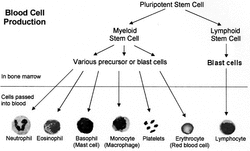 ~The Most Curable Option for SCD~ Author: Kara Martina, B. Sc. Biopsychology More than often we hear news stories about this elusive Bone Marrow Treatment and how it helps those with Sickle Cell Anemia. Despite its success, many people remain ignorant about Bone Marrow Transplants (BMT) and its potential life-saving effects for those with anemia or cancer. This lack of knowledge leaves people apathetic and unaware of how to become a Bone Marrow donor. So: what are Bone Marrow Transplants and how do they work? Are they Successful? According to Blood Journal, a matched Bone Marrow transplant remains the only curative strategy for Sickle Cell Diseases (1). The first success was reported in 1984 in a patient with coexisting acute myeloid leukemia (2). Not without potential grafting complications and extensive conditioning regimens, Bone Marrow Transplants are considered effective. The greatest success rate was reported in 2011 with overall survival and event-free survival of 93% and 86%, respectively (3).The most recent article published in JAMA, July 2 2014 announced that 29 out of 30 Sickle Cell patients successfully underwent a matched Bone Marrow Transplant (4). How does it work? Bone Marrow donors are matched based on immune system markers, and once an allogeneic match is found, their bone marrow is harvested. More likely to be a brother or sister, a World Wide Marrow Bank is also used to find close matches. The replacement bone marrow cells grow into normal blood cells without the sickle-shaped deformities. What is Bone Marrow? Where your body makes the components of blood. Bone marrow is the soft sponge-like material in the centre of bones. Large flat bones such as the breastbone (sternum) and pelvis contain the most bone marrow (5). To make blood cells constantly you need a healthy bone marrow. What does Bone Marrow in Sickle Cell Patients look like? From the beginning, stem cells from the bone marrow in a person with Sickle Cell Anemia are programmed to produce Sickle Blood cells. How are BMTs done? First, the defective bone marrow needs to be partially or fully wiped out. A course of radiation or chemo or both is used to wipe out defective marrow. Often the hardest and most tiring time during BMT, this first step alone has taken lives before the procedure can even be completed. Difficult for the individual and the family, this chemo/radiation takes a heavy toll on the body and often perturbs people form choosing BMT. More research into creating less devastating effects of the first stage continues. Second, the healthy bone marrow is injected, delivered into the patient’s bloodstream (6). Described by some as ‘similar to getting a blood transfusion,’ the stem cells travel through the blood into the bone marrow. Most times, no surgery is needed. How can I donate/become a bone marrow donor? Simply register! To become a donor it only takes a small vial of blood or swab of cheek cells to be typed as a bone marrow/stem cell donor. It’s like saying to anemia and cancer communities alike, “I’m here!” Minor costs may apply for HLA tissue typing. If someone needs your bone marrow, you’ll be contacted and harvested. Screening is often rigorous, but given the benefits of healthy bone marrow—it’s worth the effort! Individuals wishing to register can: · Call 1-888-236-6283 (1-888-2-DONATE) · Create an account and appointment with blood.ca (create username and password) · Contact Kyshah Powell at: [email protected] · Outside of North America visit here. References 1. M.M. Hsieh, C.D. Fitzhugh and J.F. Tisdale. Allogeneic hematopoietic stem cell transplantation for sickle cell disease: The time is now. Blood. Vol. 118, August 4, 2011, p. 1197. doi: 10.1182/blood-2011-01-332510. 2. Johnson FL, Look AT, Gockerman J, Ruggiero MR, Dalla-Pozza L, Billings FT 3rd. Bone-marrow transplantation in a patient with sickle-cell anemia. N Engl J Med 1984;311(12):780-783. 3. Bernaudin F, Socie G, Kuentz M, et al. Long-term results of related, myeloablative stem cell transplantation to cure sickle cell disease. Blood 2007;110(7):2749-2756. 4. M. M. Hsieh et al. Nonmyeloablative HLA-Matched Sibling Allogeneic Hematopoietic Stem Cell Transplantation for Severe Sickle Cell Phenotype. JAMA. Vol. 312, July 1, 2014, p. 48. doi:10.1001/jama.2014.7192. 5. Kenny, Tim. (2012). Stem Cell Transplant. Retrieved July 10, 2014 from http://www.patient.co.uk/health/Stem-Cell-Transplant.htm 6. A. D. A. M. (2013). Bone Marrow Transplant. The New York Times. Retrieved from http://www.nytimes.com/health/guides/surgery/bone-marrow-transplant/overview.html
1 Comment
|
AboutThis section is solely to let our Sickle Soldiers tell their story trials & tribulations alongside things they feel are wrong in the Sickle Cell Community Archives
March 2016
Categories
All
|
 RSS Feed
RSS Feed
